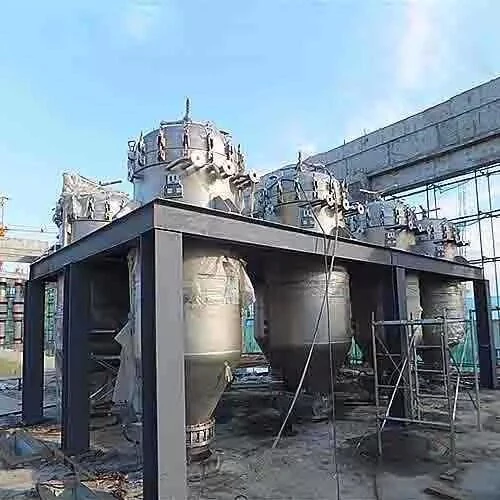Advancements and Challenges in China Pressure Vessel Industry (Part Two)

2. Deformation Challenges
Deformation in pressure vessels poses significant threats to their reliability and operational safety. The meticulous formulation and strict adherence to manufacturing processes and standards are paramount to ensuring that the quality of pressure vessels aligns with national regulations and various industry standards. The occurrence of deformation during the manufacturing process can be attributed to errors in the size of the blank, issues in the assembly process, and irregularities in the shape of the mold.
To effectively address deformation challenges, a comprehensive approach is required, touching upon three key aspects. First and foremost is the imperative to elevate the precision of cutting processes, incorporating advanced computer software to assist in material calculations and management. This not only enhances accuracy but also contributes to efficient blanking processes. The second aspect involves the meticulous control of the mold shape, taking into consideration any changes that may occur during and after the molding process. This requires a keen focus on ensuring the structural integrity of the mold to minimize any potential deformations in the final product.
In the assembly phase of the pressure vessel, strategic measures are employed to prevent deformation. The utilization of positioning fixtures proves invaluable in maintaining the equipment's structural integrity, while the application of theodolites aids in assessing and ensuring the straightness of the vessel. Symmetrical cutting and machining are adopted during actual operations to counteract potential deformations. For instances of unstable deformation, the reinforcement of the opening area with ribs near the shell becomes a prudent practice. Additionally, in cases where heat treatment may induce deformation, implementing a firewall at the flame nozzle of the furnace wall and reinforcing parts prone to temperature loss at high temperatures are critical measures.
3. Welding Challenges
Welding is a critical component in the manufacture of pressure vessels, serving as the nexus for connecting various components. The arrangement and quality of welds directly influence the overall quality and safety of the pressure vessels. Of particular concern are weld defects and stress concentration, which necessitate careful scrutiny during the welding process. A thorough analysis of weld arrangement, intersection, and overlap is essential for pre-operation stress analysis.
To address welding challenges effectively, the professional level of the operators undertaking welding activities emerges as a pivotal factor. The quality of welding is significantly influenced by the expertise of the operators, making it imperative to institute robust management practices. This includes a comprehensive review of operator qualifications and related certifications to ensure compliance with industry standards and regulations.
4. Stress Corrosion Challenges
Stress corrosion cracking, stemming from the interplay of stress and corrosive environments, presents a formidable challenge in pressure vessel manufacturing. Stress, an unavoidable factor in actual operational processes, coupled with corrosive environments, necessitates a multifaceted approach to mitigate the risks associated with stress corrosion.
To address stress corrosion challenges effectively, a proactive strategy begins with a meticulous consideration of these issues during the design phase. This involves a comprehensive evaluation of potential stress corrosion problems and the selection of materials that can withstand such conditions. Structural treatments, heat treatment processes, and anti-corrosion measures are then implemented to minimize the possibility of cracks arising due to stress corrosion.
5. Hydrogen Embrittlement Challenges
Hydrogen embrittlement, colloquially known as white spots, introduces a unique set of challenges in the manufacturing of pressure vessels. This phenomenon occurs when hydrogen dissolved in steel polymerizes into molecules, causing stress concentration that surpasses the strength limit of the steel and results in the formation of fine cracks.
Preventing hydrogen embrittlement requires a nuanced approach, primarily focusing on the materials used in pressure vessel construction. The addition of specific elements such as chromium, titanium, and vanadium to steel can aid in reducing the occurrence of hydrogen embrittlement. Corrosion inhibitors, electroplating, sandblasting, and rust removal techniques also contribute to minimizing the risks associated with hydrogen embrittlement.
It is crucial to note that hydrogen embrittlement is a phenomenon that can only be prevented and not repaired. Once hydrogen embrittlement occurs, it cannot be eliminated. Moreover, the severity of hydrogen embrittlement increases with higher temperatures and higher carbon content in steel.
Nondestructive Testing
Ensuring the quality of pressure vessels post-manufacturing is a critical step, and quality inspection is imperative before the finished product leaves the factory. In China, the primary methods employed for this purpose are radiation testing (RT) and ultrasonic testing (UT) for welds. With the continuous innovation and development of non-destructive testing technology, the results obtained through these methods are becoming more objective and accurate.
Non-destructive testing plays a crucial role in verifying the integrity and safety of pressure vessels without causing damage to the equipment. As technology progresses, the industry can benefit from more advanced and sophisticated non-destructive testing methods, ensuring that pressure vessels adhere to the highest quality and safety standards.

